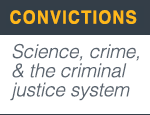On September 3, 2006, a 16-year-old boy named Bobby Johnson confessed to murdering a retiree in New Haven, Connecticut. In his statement, Johnson said he borrowed a gun from his cousin. Then he and a younger friend robbed the old man and shot him through the window of an idling car. Johnson pleaded guilty at trial. He was sentenced to 38 years in prison.
It was an open-and-shut case — or so it seemed.
 Some of the facts didn’t really line up with the confession. Fingerprints on the victim’s car didn’t match Johnson or anyone else charged with the crime. After police discovered that Johnson’s cousin hadn’t owned the gun after all, he was brought back in to “correct” the confession.
Some of the facts didn’t really line up with the confession. Fingerprints on the victim’s car didn’t match Johnson or anyone else charged with the crime. After police discovered that Johnson’s cousin hadn’t owned the gun after all, he was brought back in to “correct” the confession.
After his conviction, Johnson claimed he had only confessed because he wanted to go home and the police told him they had evidence that proved he committed the crime. He said the police told him he would be in big trouble if he didn’t confess. He had no parent with him. He had no lawyer. When he got details wrong in his confession, they chastised him for lying until he got it right.
If all of this sounds a bit familiar, it’s probably because of Brendan Dassey, the 16-year-old whose interrogation videos were a central part of the hit Netflix documentary “Making a Murderer.” Both cases involved similar interrogation techniques. When both boys said they were innocent, police told them to stop lying. In both cases, police lied about evidence tying the suspect to the crime. In both cases, police minimized the crime as “understandable” in an effort to make it easier for the suspects to admit guilt.
Since 1989, 63 people have been exonerated of crimes they were convicted of while juveniles on the basis of what later turned out to be a false confession, according to the National Registry of Exonerations. All these stories share similarities with those of Johnson and Dassey. That’s because the techniques police use to convince a suspect to confess vary little from state to state and year to year. They arise from a combination of formal training and fraternal tradition, and they grow, interestingly enough, out of mid-20th-century efforts to create more ethical, reliable interrogation tactics.
Police at the time were looking for a way to get accurate confessions without the brutal third-degree portrayed in old movies. The result was a commercially available training program called the Reid Technique, which sets extraction of a confession as a central goal. Most police in the United States — along with many of their law enforcement counterparts around the world — use interrogation techniques based on Reid.
“It’s intuitive and it makes sense. It’s very, very effective,” says Jim Trainum, a retired Washington DC homicide detective. “It’s cheap and doesn’t take a lot of time to teach. That’s why law enforcement likes it.”
But a growing body of psychology and sociology research suggests the Reid Technique and its derivations contribute to the production of false confessions. The United Kingdom reformed its interrogation process, based on this research, in the early 1990s, establishing a system geared more toward gathering evidence rather than obtaining a confession. American law enforcement, though, is worried about losing valuable tools that help them catch bad guys, Trainum says.
Unfortunately, when these tools are used on people who are especially prone to confessing falsely — like children or the intellectually disabled — the results can be disastrous. And the law does not protect them.
Nobody knows how frequently people confess to crimes they didn’t commit, but in cases where prisoners were later exonerated by DNA evidence, as many as 25 percent of them had confessed. Most false confessions come from murder cases. A 2004 review of the literature on false confessions found that the two biggest predictors were youth and intellectual disability.
Johnson, for instance, had an IQ of 69, but there are few legal protections for people like him. Police cannot hurt or threaten suspects, but many psychological techniques — including lying about evidence — have been widely upheld as non-coercive. Juveniles are entitled to have their parents present during an interrogation, but that doesn’t always happen and it doesn’t always help. For instance, one of the Central Park Five, a group of teenage boys who falsely confessed to the rape of a jogger in 1989, had his parents in the room for his interrogation, says Saul Kassin, a professor of psychology at John Jay College of Criminal Justice in New York and an expert in the study of false confessions. The boy confessed after 20 hours of interrogation, when his father suggested he just tell the cops what they wanted to hear so the family could go home.
The only potential remedy in such cases comes during the trial, after the confession, if the suspect’s lawyer can prove the confession was coerced and shouldn’t count as voluntary — but that’s an exceedingly high bar. Mental state is one factor courts consider in determining whether a confession was coerced, but in 1986, the Supreme Court ruled that it cannot be the only factor. It’s not enough to just have a young brain, or a differently functioning brain, or a brain that has a hard time making sense of the statement “you have the right to remain silent.” Defendants have to prove police misconduct, and that the misconduct directly caused the coerced confession.
“There are no laws, if that’s what you’re asking, to protect specially vulnerable people,” Kassin told me.
That’s a problem. Neuroscience research over the last 30 years has shown that the prefrontal cortex – the part of the brain involved in problem-solving, regulation of emotion, evaluation of risk and reward and other “executive” functions – isn’t fully developed until around age 25. All those things have an impact on how someone would deal with hours of intense interrogation, how they would respond to false evidence, and what they would think if authority figures repeatedly told them that reality didn’t match their own memories.
In a 2003 paper, for instance, researchers found evidence that age was correlated to a person’s propensity to confess to a mistake they hadn’t made. The scientists told subjects they were doing a reaction time experiment on a computer. They had to press keys as fast as they could in response to stimuli, but they were told to never press the ALT key, or the computer would crash. In reality, the computer was programmed to crash regardless of what the subjects did. The scientists then accused them of pressing the ALT key and tried to get them to sign confessions and agree to come back and spend 10 hours re-entering the lost data.
Seventy-eight percent of 12-and-13-year-old subjects signed the confession. Fifty-nine percent of 18-to-26-year-olds complied.
Evidence also shows that people who are intellectually disabled are at a heightened risk of false confession. In a 1995 study, researchers showed average and low-IQ adults videos of police interrogations and asked them questions about their perceptions. The results were troubling and demonstrate how easy it is for the intellectually impaired to end up in a situation they can’t cognitively handle — and to confess without understanding the consequences.
Only 52 percent of disabled adults thought an innocent person should ask for legal help if they were being interrogated. 38 percent thought that a person who confessed to murder would be allowed to go home until the trial. And while all of the adults with average intellects understood that a person convicted of murder would go to prison, five percent of the disabled adults thought the convicted murderer would just be fined. Another 10 percent thought he would be sent to a hospital.
This is particularly problematic because intellectual impairment isn’t always obvious — even to police interrogators. People with fetal alcohol syndrome, for example, can fall through the cracks because they often have no physical sign of impairment. Their IQs might even technically be in the range of average — a fact that can obscure real disability, says Stephen Greenspan, a developmental psychologist specializing in the study of cognitive disabilities among people accused and convicted of crimes. Someone could have an IQ of 80 — just five points above the DSM-V cutoff for intellectual impairment — but also have an executive processing disability that means they function at a much lower level.
Research like this led Trainum, the former detective, to become a crusader for interrogation reform. In 1994, he realized that his own interrogation technique had elicited a false confession in a murder case. Today, he gives presentations to working officers on how to avoid those kinds of errors. But he gets pushback.
“Some of them think I’m full of shit. Others, behind closed doors, will say they’ve made those mistakes, too,” he says.
But even those officers, Trainum says, have a tendency to think that false confessions, while real, only happen to other people.
Bobby Johnson’s conviction was vacated in September of last year. In the end, his freedom had less to do with his mental state as a child with a low IQ and more to do with the fact that the detectives who interrogated him had ignored evidence and were accused of skimming money from funds meant to pay confidential informants. In fact, an earlier petition that cited Johnson’s claims of false confession had been denied. There simply wasn’t enough evidence, the judge said, to prove the confession was coerced.
Most interrogations aren’t recorded until after a confession has already been obtained. Police interrogate a suspect, get them to confess, and then turn on an audio or video recorder so the accused can repeat the confession for posterity. Everything that led to that moment is lost.
That’s important because while a 1969 Supreme Court ruling made it legal for police to lie to and mislead a suspect as part of an interrogation, it also set a subjective limit on what police can and cannot do. Legally, interrogations become coercive when they “shock the conscience of the community.” But the community cannot be shocked by what it doesn’t see. If police had not filmed Brendan Dassey’s interrogation, the outcry among viewers of “Making a Murderer,” which has been substantial, would never have been heard. This is why Kassin and other experts think that all interrogations should be filmed from beginning to end.
Trainum would go further, calling for an end to the presentation of false evidence by police in order to draw out a confession. Courts have generally allowed the technique on the assumption that it alone would not be enough to push a person to confess to a crime they didn’t commit. But when combined with implied threats and promises of leniency, he says, the fake evidence becomes more powerful — particularly among populations lacking the cognitive ability to fully comprehend the rhetorical net being woven to ensnare them.
Trainum said police departments are unlikely to abandon the technique willingly.
“But we’re very resourceful people in law enforcement,” he added. “When Miranda happened, we thought we’d never get another confession. But we do.”
Maggie Koerth-Baker is an American science journalist, former New York Times Magazine columnist, and current senior science reporter for the website FiveThirtyEight.










